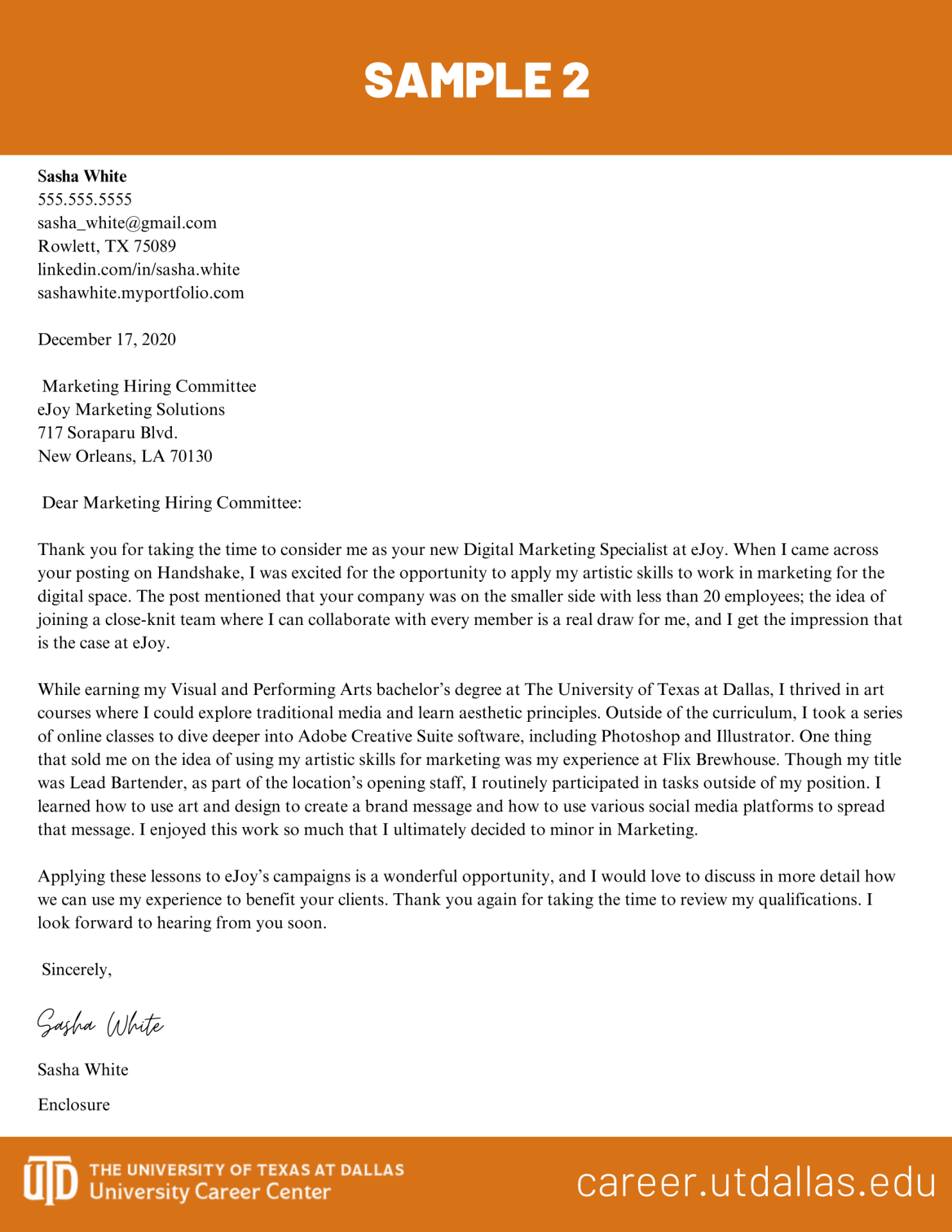Resume & Cover Letter
Study the samples and explore the dropdowns in the tabs below to learn how to craft a quality resume and cover letter.
Resume
Resume
View the video guides under each section for detailed information!
Name & Contact
Keep it simple. Name should be 14-18pt font, and contact information should be 11-12pt font.
Add links such as LinkedIn, GitHub, or other professional portfolio sites.
Make sure that this section is located at the top of the page. Do not put it in the header section of Word/Google Docs (that is, in the top margin) to ensure readability and Applicant Tracking System (ATS) compliance.
Summary
Summary (also called the Profile) is optional. If you choose to include this, make sure that it is highly tailored to the field you are pursuing.
Express your goals and value beyond “looking for a summer internship”.
The Summary should be located between your Name & Contact and your Education sections.
Education
Arrange your Degree and University along the left margin and your expected Graduation Date and GPA (if it is above a 3.5) along the right margin. Consider putting your Degree in bold to better highlight your skills and knowledge.
Relevant Coursework
Align on the left margin and make a list or use bullet point formatting to ensure Applicant Tracking System compliance. Only list coursework that clearly demonstrates your value.
Be sure to spell out the title of the class; most people outside of UTD will not recognize the course abbreviation/numbers.
Skills
Classify your skills if you have many. Otherwise, start at the left margin and make a list. As long as you can honestly speak to your ability, you can add it to your Skills section. Don’t sell yourself short!
Soft skills (for instance, communication, active listening, customer service) do not go in the Skills section. Rather, work these into your bullet points.
Experiences
Experiences can be Professional or Academic. In both cases, be sure to build out the sections like you would for a job—clearly demonstrate the skills you used and the results you gained.
For Academic Experience, do not simply discuss the end results of the app you built or the topic you wrote a paper about. Keep in mind that you likely will not be hired to create that exact app again, but you will be called upon to use those hard and soft skills again.
Sell your skills, not the particular project.
Bullet Points
Start with a strong action verb. Try not to repeat the same verb.
Be specific—you want the potential employer to clearly picture your skillsets and work style.
Add metrics—quantify where possible.
Use a model like W-H-O (What you did, How you did it, Outcome/Purpose) to ensure that you are covering all the important information.
The SOAR method, which stands for Statement of Action (what you did), Occurrence of Action (how often the action occurred), Amount of Action (how much or how many), and Result of Action (outcome of your efforts), is another effective way to demonstrate your achievements on a resume.
See our full guide for more examples of the W-H-O model and for other effective models.
Organizations, Community Service, & Leadership
Add any experiences that you believe will help showcase you as a professional.
Athletics or other non-industry organizations can be added; however, be sure to prioritize industry-related content on your resume.
Do not add hobbies unless it is affiliated with an organization (for instance, a UTD Baking Club would be alright to list. However, you would not want to list simply “baking”.
Awards & Honors
Awards and honors can go close to the end of your resume.
You can also consider adding scholarships as part of your Education section.
Cover Letter
Cover Letter
Cover letters are one page or less and consist of formal business writing. Although not always required, they can help to show your personality, dedication, and value, as well as set you apart from other applicants.
Video Guide
What is a Cover Letter?
A cover letter is a personalized document submitted with your resume that:
- Explains why you are interested in the job.
- Highlights your most relevant skills and experiences.
- Connects your background to the employer’s needs.
Before You Write
Read the job description carefully.
Research the company (website, mission, values, recent news, etc.).
Identify your 2-3 strongest qualifications for the role.
Structure Overview
The header and contact information should match your resume.
Greeting: Use the recruiter or hiring manager’s name if known, or use a general greeting like, “Dear Hiring Committee,” if needed.
Introduction Paragraph
State the position and mention how you found it.
Say why you are excited about the company (include something specific).
Middle Paragraph(s) – “Sell Yourself”
This is the core of your cover letter.
Highlight 1-2 key experiences or skills.
Use results or examples to show how you meet the needs of the role.
Align with the job posting.
Closing Paragraph
Express enthusiasm.
Restate your contact information and interest.
Thank the reader for their time and consideration.
Signature: Include “Sincerely,” and your name.
Quick Tips
Keep it to 1 page.
Match the style of your resume (use the same font and layout feel).
Save it as a PDF to avoid formatting issues.
Avoid templates with graphics or columns (ATS may block them).
Proofread carefully: read it aloud or use a tool like Grammarly.

